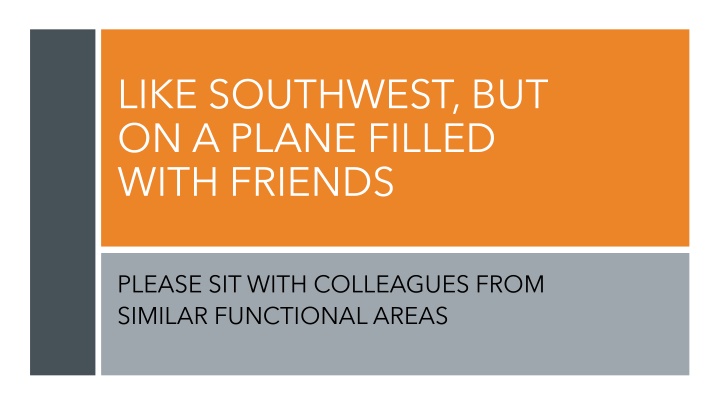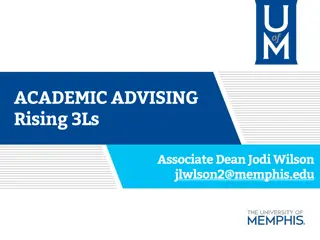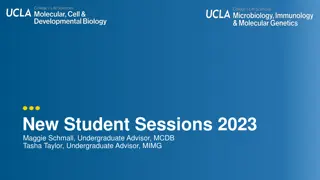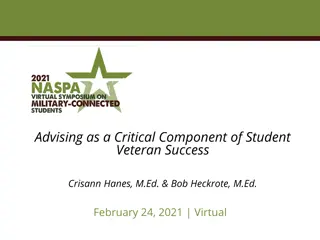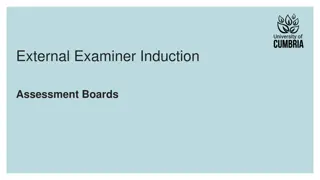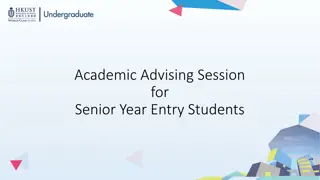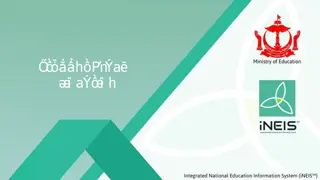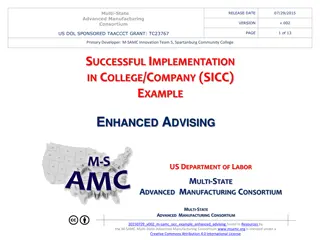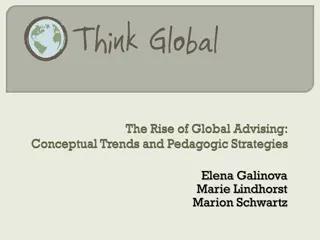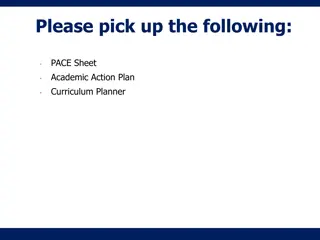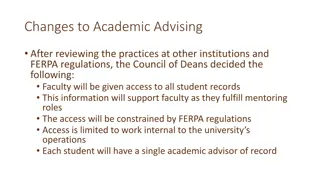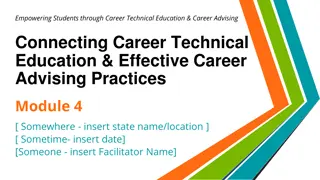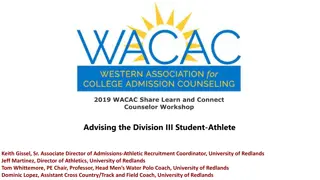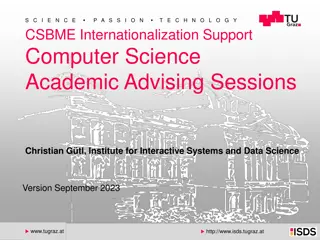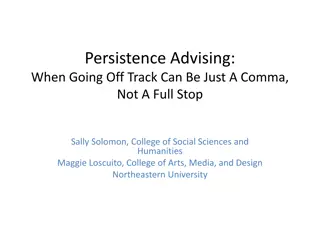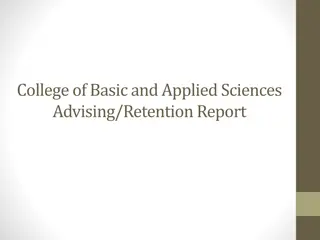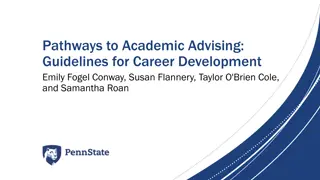Academic Advising and Student Progression
Reflecting on the dynamic landscape of academic advising, this content explores the roles, resources, and changing demographics shaping today's college student experience. From past advising ecosystems to present challenges, the focus is on enhancing student success through intentional planning and collaborative support structures.
Download Presentation

Please find below an Image/Link to download the presentation.
The content on the website is provided AS IS for your information and personal use only. It may not be sold, licensed, or shared on other websites without obtaining consent from the author.If you encounter any issues during the download, it is possible that the publisher has removed the file from their server.
You are allowed to download the files provided on this website for personal or commercial use, subject to the condition that they are used lawfully. All files are the property of their respective owners.
The content on the website is provided AS IS for your information and personal use only. It may not be sold, licensed, or shared on other websites without obtaining consent from the author.
E N D
Presentation Transcript
LIKE SOUTHWEST, BUT ON A PLANE FILLED WITH FRIENDS PLEASE SIT WITH COLLEAGUES FROM SIMILAR FUNCTIONAL AREAS
DANIEL A. BROWN, PH.D. ACADEMIC ADVISING PLANNING FOR SUCCESS STUDENT FACULTY INSTITUTION DEAN | DIRECTOR | PRINCIPAL INVESTIGATOR
TODAYS CONVERSATION Exploring roles and expectations for academic advising Reflecting on demands on the advising ecosystem Describing our advisees Planning to meet their hierarchy of needs What information will be helpful as CSU-Pueblo develops an intentional and inescapable plan for academic advising?
OUR ACADEMIC ADVISING EXPERIENCES IN COLLEGE For the next 8-10 minutes, let s think back to our college experiences What resources were most valuable as you progressed toward the baccalaureate degree? Who was your advisor ? Did you receive information that would have helped you succeed? What information (if any) was not made available? Individual reflection (2-3 minutes), shared conversation (5 minutes), report out to the group
YESTERDAYS ADVISING ECOSYSTEM Class Schedule Advisor Diploma Student Faculty
TODAYS ADVISING ECOSYSTEM Class Schedule Advisor Diploma Registrar Title IV Aid Peers Student Family VA Info Tech Benefits Faculty Study Abroad NCAA
TODAYS ADVISING ECOSYSTEM System State Agency University Federal Department Accreditor
WHO ARE OUR STUDENTS? HOW HAVE THEY CHANGED? When we were in college 12.2 million nationally (1985) 52.5% female Overwhelmingly white Middle-to-upper income predominated Relatively inexpensive for publics Many first-generation students Today s college student 22.5 million nationally (2019) 58.2% female Ethnically heterogeneous All income levels represented Increasingly expensive Many first-generation students
A MAJOR SHIFT | STUDENT LOAN DEBT Student loans in 2019: A snapshot Amount of student loan debt outstanding in the USA Percent of college attendees taking on debt, including student loans, to pay for their education Average amount of student loan debt per borrower Percent of adults with a student loan Amount of student loan debt that is at least 90 days past due or in default $1.41 trillion 54% $35,359 14.4% 10.8% $1.06 trillion in student loan debt only five years ago!
ARTICULATING AND PLANNING FOR ACADEMIC ADVISING SUCCESS Developing mission / vision statements and goals Developing policy and priorities See Texas State University Undergraduate Academic Advising Policies Defining the ecosystem Develop a marketing and communications strategy regarding academic advising Benchmark advising services through authentic assessment
TODAYS CSU-PUEBLO STUDENTS | WHAT DO THEY NEED? For the next 8-10 minutes, let s think about what CSU-Pueblo students need from academic advising Based upon these needs, who is in the CSU-Pueblo ecosystem? Who is not currently at the table with respect to your advising ecosystem? Individual reflection (2-3 minutes), shared conversation (5 minutes), report out to the group
AFTER COUNTING HEADS, YOU CAN MOVE TO A NEW SEAT PLEASE SIT WITH COLLEAGUES FROM SIMILAR FAMILIES OF DISCIPLINES
DEVELOPING AN ADVISING FRAMEWORK BASED UPON STUDENT NEEDS Faculty Advisors Hybrid Model Professional Advisors
MODEL CONSIDERATIONS | FACULTY AS ADVISORS Strengths Direct link to the curriculum | content experts Opportunities to learn about career and graduation education opportunities Academic engagement Concerns Increasing compliance expectations Continuing professional development Value within tenure and promotion system
MODEL CONSIDERATIONS | PROFESSIONAL ACADEMIC ADVISORS Strengths Advisor assignments and availabilities can be clearly articulated to students Clear expectations for performance as academic advisors Simplifies professional development and communication across the curriculum Concerns Professional advisors lack deep knowledge of discipline Professional academic advisors are discipline agnostic Easy to overwhelm advising staff with additional duties
MODEL CONSIDERATIONS | A HYBRID MODEL Strengths Expands the number of available advisors for students Provides some flexibility and synergy with specific programs An option during times of transition Concerns Less clarity for the advisee May lead to challenges with respect to responsibility and authority Professional development may be challenging Should be part of a plan and not a destination
ASSESSING QUALITY OF ACADEMIC ADVISING IS KEY How are you assessing the quality of academic advising at CSU-Pueblo? Direct measures? (Knowledge / skill acquisition) Indirect measures? (Nationally-normed surveys) Formative versus summative assessment is key to program improvement How will you measure change in the academic advising ecosystem? Awareness of advising reputation and advisor whole employee life is crucial
WHAT HAVE I LEFT OUT? QUESTIONS? As our workshop concludes, let s reflect on CSU-Pueblo faculty and staff questions about academic advising on campus What questions do you have? What information do you need? Individual reflection (1 minute), shared conversation (2-3 minutes), report out to the group
WEVE REACHED OUR DESTINATION! DR. DANN BROWN 512-245-3579 DANNBROWN@TXSTATE.EDU
